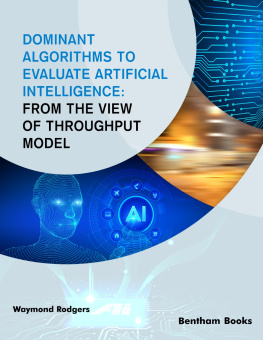Abstract
Abstract
We have seen AI providing conversation and comfort to the lonely; we have also seen AI engaging in racial discrimination. Yet the biggest harm that AI is likely to do to individuals in the short term is job displacement, as the amount of work we can automate with AI is vastly larger than before. As leaders, it is incumbent on all of us to make sure we are building a world in which every individual has an opportunity to thrive.
---Andrew Ng, Co-founder and lead of Google Brain
The AI of the past used brute-force computing to analyze data and present them in a way that seemed human. The programmer supplied the intelligence in the form of decision trees and algorithms. Imagine that you were trying to build a machine that could play tic-tac-toe. You would give it specific rules on what move to make, and it would follow them. Today's AI uses machine learning in which you give it examples of previous games and let it learn from the examples. The computer is taught what to learn and how to learn and makes its decisions. What's more, the new AIs are modeling the human mind itself using techniques similar to our learning processes.
---Vivek Wadhwa
Google's work in artificial intelligence ... includes deep neural networks, networks of hardware and software that approximate the web of neurons in the human brain. By analyzing vast amounts of digital data, these neural nets can learn all sorts of useful tasks, like identifying photos, recognizing commands spoken into a smartphone, and, as it turns out, responding to Internet search queries. In some cases, they can learn a task so well that they outperform humans. They can do it better. They can do it faster. And they can do it at a much larger scale.
---Cade Metz
Abstract
The Fourth Industrial Revolution generation has ushered in extremely sophisticated digital apparatuses that have taken the place of manual processing to ensure higher automation and sophistication. Artificial Intelligence (AI) provides the tools to exhibit human-like behaviors while adjusting to the newly given inputs and accommodating
change in the environment. Moreover, the tech-giants such as Amazon, Apple, IBM, Facebook, Google, Microsoft, and many others are investing in generating AI-driven products to facilitate the market demands for sophisticated automation. AI will continually influence areas such as job opportunities, environmental protection, healthcare, and other areas in economic and social systems.
Keywords: Algorithms, Artificial intelligence.(AI), Audit, Bias, Big data, Cognitive automation, Decision choice, Deep learning, Digital workforce, Financial robots, Information, Judgment, Machine learning, Natural language processing (NLP), Neural networks, Perception, Robotic process automation (RPA), Throughput Model, Transparency.
INTRODUCTION
The development of artificial intelligence (AI) has transformed our economic, social, and political way of life. Tedious and time-consuming tasks can now be delegated to AI tools that can complete the work in a matter of minutes, if not seconds. Within the world of business, this have significantly decreased the time required to conclude transactions. Nonetheless, there is always the fear of a person being replaced by AI tools for the sake of cost and time efficiency. Although these fears are valid in some arenas, AI is not developed enough to completely replace a humans judgment or expertise in a variety of situations. Moreover, AI can be considered as a tool that should be fully embraced to improve an individual or organization efficiency and effectiveness when performing a task. Within the human resource department, machines can be used throughout the entire process.
This book presents a decision-making model described as the Throughput Model, which houses six dominant algorithmic pathways for AI use. This modeling process may better guide individuals, organizations, and society in general to assess the overall algorithmic architect that is guiding AI systems. Moreover, the Throughput Modeling approach can address values and ethics that are often not baked into the digital systems, which assembles individuals decisions for them. Finally, the Throughput Model specified six major algorithms (to be discussed later) that may augment human capacities by countering people's deepening dependence on machine-driven networks that can erode their abilities to think for themselves, act independent of automated systems and interact effectively with others []. The Throughput Model dominant six algorithms can be utilized as a platform for an enhanced understanding of the erosion of traditional sociopolitical structures and the possibility of great loss of lives due to accelerated growth of autonomous military applications. Further, the model may assist in the understanding of the use of weaponized information, lies and propaganda to dangerously destabilize human groups.
AI is the ability of a computer, machine or a robot controlled by software to do tasks that are typically performed by humans since they require human intelligence and discernment. In other words, AI can simulate humans style of living and work rules, as well as transform people thinking and actions into systematized operations. Scientists have discovered more about the brain in the last 10 years than in all prior centuries due to the accelerating pace of research in neurological and behavioral science and the development of new research digital techniques [].
In addition, neurological brain research experts have found that the human brain has approximately 86 billion neurons, and each neuron is divided into multiple layers [].
Furthermore, digital life is augmenting human capacities and disrupting eons-old human activities. Algorithmic driven systems have spread to more than half of the worlds inhabitants in encompassing information and connectivity, proffering previously unimagined opportunities. AI programs are adept of mimicking and even do better than human brains in many tasks []. Likewise, whether an AI system acts as a primary decision maker, or as an important decision aid and support to an individual decision maker, will suggest different regulatory approaches.
Fundamentally, the goal of an algorithm is to solve a specific problem, usually defined by someone as a sequence of steps. In machine learning or deep learning, an algorithm is a set of rules given to an AI program to help it learn on its own. Whereby machine learning is a set of algorithms that enable the software to update and learn from prior results without the requirement for programmer intervention. In addition, machine learning can get better at completing tasks over time based on the labeled data it ingests. Also, deep learning can be depicted as a related field to machine learning that is concerned with algorithms stimulated by the structure and function of the human brain called artificial neural networks [].









